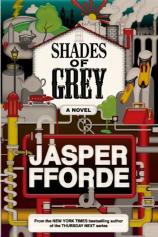Shades of Grey
Review
Shades of Grey
At first, Jasper Fforde’s latest book, SHADES OF GREY, is
a difficult read. It is set in the distant future, in a world
nearly unrecognizable technologically and culturally. But as we
follow the story of young Edward Russet, poised for adulthood in a
civilization that discourages his inquisitiveness and imagination,
we are eased into Fforde’s strange world and captivated by
it.
Chromatacia is ruled by the Colorocracy, a social hierarchy and
government based on the amount of color perception each individual
and family has. Eddie Russet comes from a less-than-powerful red
family. But his half-promise to Constance Oxblood, if it comes to
fruition in marriage, would be a move up in the hued ranks for him
and, because of his high hue perception, insurance that the Oxblood
line would increase their red in the next generation.
Unfortunately, the young couple’s plans are thwarted when
Eddie and his father, a swatch guard, are moved out to the Outer
Fringes to an odd village called East Carmine. In just four days,
Eddie’s life is threatened numerous times, his half-promise
to Constance is challenged, he falls in love with a violent and
sarcastic revolutionary Grey named Jane, impregnates a Purple named
Violet deMauve, and comes close to uncovering the mysteries on
which his society is based.
From carnivorous roads and predatory trees to the shortage of
spoons and the narcotic effects of the color green, from ghosts and
ghost towns to leapbacks and reboots, the Chromatic world is a
strange and uneasy one indeed. Fforde, in introducing readers to
this world, poses more questions than he offers answers. In almost
400 pages of reading, we never learn who Munsell is, what his
epiphany was, or anything about the event that changed the world. A
close look at the book’s end pages reveals this is the first
in an intended series following Eddie and Jane, and then it becomes
apparent that Fforde may just be laying the groundwork for the
action that comes later. Yet, even with the unanswered questions,
Fforde’s Chromatacia is rich and vivid enough and the tale
quirky and compelling enough to satisfy.
Eddie’s adventure becomes more interesting as the story
unfolds. But it does require some patience from readers. In
creating this darkly fantastical future, Fforde has envisioned not
just new and unfamiliar technologies and a radical form of
government but characters who seem not quite human, or at least a
different form of humanity. Their eyes and cortexes work
differently from ours, and their statures are generally smaller
than ours as well. Despite their dissimilarities to us and their
world to ours, SHADES OF GREY is a satirical comment on current
state of affairs reminiscent of other dystopias.
This book is clever, absurd and witty, and the color references
are non-stop. Fforde plays with themes of oppression, the accuracy
of history and archaeology, economics and romance. Plus, there are
murders to solve and Eddie’s coming-of-age ceremony to
attend. At times, SHADES OF GREY gets bogged down in its own
details, and while not a masterpiece of literature, it is an
enjoyable and creative novel that takes science or speculative
fiction in a new direction.
Reviewed by Sarah Rachel Egelman on January 23, 2011
Shades of Grey
- Publication Date: December 29, 2009
- Genres: Fiction
- Hardcover: 400 pages
- Publisher: Viking Adult
- ISBN-10: 0670019631
- ISBN-13: 9780670019632




